- Author Matthew Elmers [email protected].
- Public 2023-12-16 21:49.
- Last modified 2025-01-24 09:17.
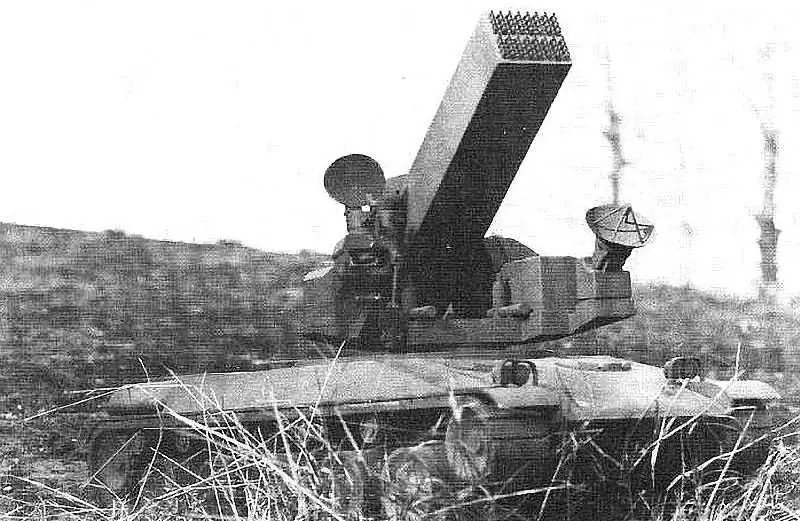
In the early stages of the development of anti-aircraft missile systems, various projects of complexes using salvo firing unguided rockets were repeatedly proposed. Systems of this kind were a temporary solution, and the advent of full-fledged guided missiles made them unnecessary. Nevertheless, such ideas were not forgotten. In the early seventies, a project of the original air defense system called AMX Javelot was being worked out in France.
Within the framework of international cooperation
Work on the new project started in 1970 and was carried out within the framework of military-technical cooperation between France and the United States. The bulk of the funding was provided by the United States, while the design work was carried out by French specialists. The finished sample was supposed to go into service with France, and could also be exported.
The general coordination of the project was carried out by the Directorate of Land Armaments (Direction technique des armements terrestres - DTAT). The development of the fixed assets of the air defense missile system was entrusted to the Thomson-CSF company. Ateliers de construction d'Issy-les-Moulineaux was responsible for preparing the required chassis and integrating the systems.
The project of the new air defense system received the working designation Javelot ("Dart"). In modern sources, the names AMX Javelot and AMX-30 Javelot are found, indicating one of the developers, as well as the type of base chassis.
The project was based on an interesting idea that involved the combination of missile and artillery technology. It was proposed to arm the air defense system with a launcher for salvo firing with rockets. Thus, in one complex, the principle of aimed fire, as in artillery, was combined with missile technology.
Tank with missiles
The promising AMX Javelot air defense system was proposed to be built on the basis of the existing tank chassis. It was borrowed from the AMX-30 tank, which showed acceptable characteristics of mobility and carrying capacity. It was proposed to remove the tower and part of the internal units. In place of the manned compartments and the fighting compartment, updated crew jobs and reloading equipment were placed.
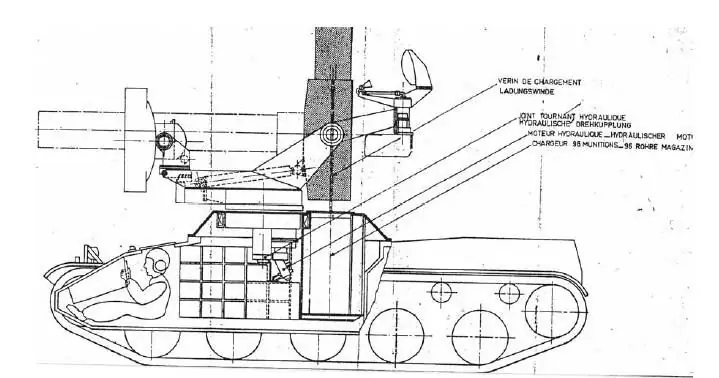
For "Dart" developed a new combat module, installed in place of the tank turret. It was built on the basis of a U-shaped pivot support with fasteners for the necessary devices. A swinging launcher with a hydraulic drive was placed in the center, and on the sides were the antennas of two radars for different purposes.
According to the project, the launcher was an armored package with 96 tubular guides for unguided missiles. The caliber of the guide was only 40 mm, which made it possible to place a large number of missiles on the installation of limited dimensions. The guides were installed with a slight separation to the sides. The launcher had electric launch controls that provided salvo firing in different modes.
The project provided for the possibility of reloading the launcher. For this, a mechanized stowage with a vertical arrangement of ammunition was located inside the hull. After the missiles were used up, the launcher had to rise to a vertical position, which made it possible to feed new shells into it and continue firing.
It was proposed to equip the Javelot air defense system with two radars for target detection and fire control. Separate optical devices were also provided for target search and shooting. Data from all means of search and guidance were issued to operator consoles.
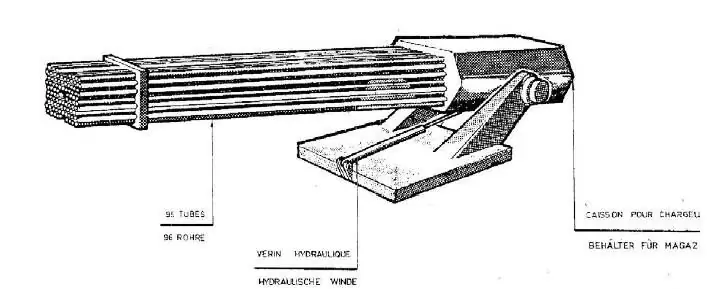
An original ammunition was developed for "Dart" - an unguided missile capable of operating in near-zone air defense. The rocket had a length of only 370 mm and a caliber of 40 mm. The product weighed 1030 g, of which 400 g was in the high-explosive fragmentation charge. A solid propellant engine was used, capable of providing speeds up to 1100 m / s. The effective firing range was determined at the level of 1.5-2 km. A contact fuse was used in the project, but in the future a remote fuse could appear.
The fire control system provided target tracking and data generation for firing with the necessary lead. The role of the operator was reduced to a minimum, which made it possible to further increase the likelihood of hitting a target.
The air defense missile system could fire volleys of 8, 16 or 32 missiles each. It was assumed that a massive launch of unguided missiles would cover an entire section of the target's trajectory, and the probability of a direct collision would be sufficient for its reliable destruction. The highest possible accuracy was to be ensured by effective search tools and an OMS.
Preliminary calculations showed that when firing at an "airplane" -type target at a distance of 1500 m, the probability of hitting at least one missile reached 70%. At the same time, depending on the parameters of the target's flight, the air defense system could make several volleys at it and achieve a reliable defeat. With similar characteristics, the AMX Javelot product could find application in military air defense and become an effective short-range weapon.
At the layout stage
Design work on the Javelot theme continued until 1973. At the later stages of the design, a prototype of a new anti-aircraft complex was built. It implemented the main ideas of the project, but there were significant differences. Apparently, fulfilling all plans within the constraints of the existing chassis and using the available technologies turned out to be difficult.
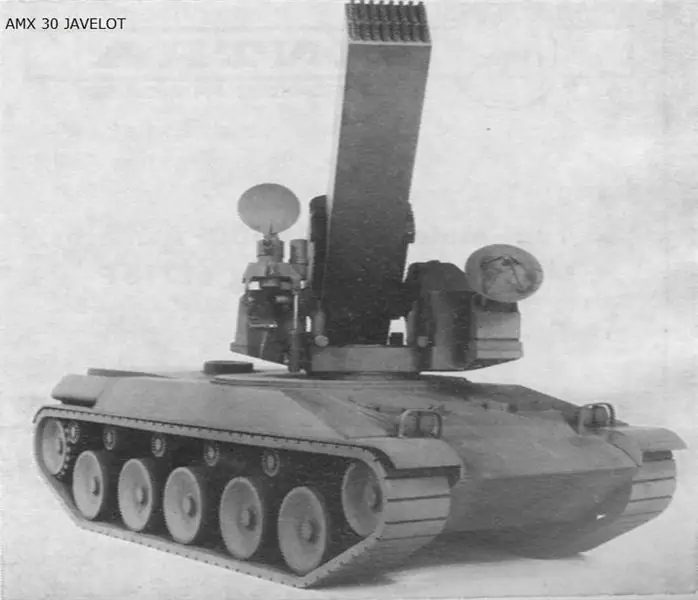
Unlike the "paper" air defense system, the model did not receive an enlarged turret box with a base for a rotary launcher. Radar facilities have changed markedly. The launcher had to be reduced, as a result of which the ammunition capacity was reduced from 96 units to 64. At the same time, the combat qualities and the probability of hitting the target could remain at the same level.
With the help of such a model, some ideas and solutions were tested, and further development paths of the project were determined. In parallel, work was underway to create a similar anti-aircraft system for the fleet called Catulle. In the near future, the first experimental air defense system, necessary for testing, was supposed to appear.
However, in 1973, all work was curtailed. A full-fledged prototype was not built. The customer found the Javelot project unpromising. Together with him, the entire direction of anti-aircraft complexes with unguided missiles was closed. In the future, France did not develop such systems.
Obvious disadvantages
In fact, the AMX Javelot product had only one positive quality - its unguided missiles were cheaper than any other SAM ammunition. However, the desire to save money on missiles led to the need to work out specific ideas, the results of which turned out to be quite modest.
The disadvantages of the complex are obvious. Light and high-speed rockets ensured destruction of targets in the near zone, but increasing the firing range was impossible. In addition, according to such characteristics, "Dart" was inferior to artillery systems of similar calibers.
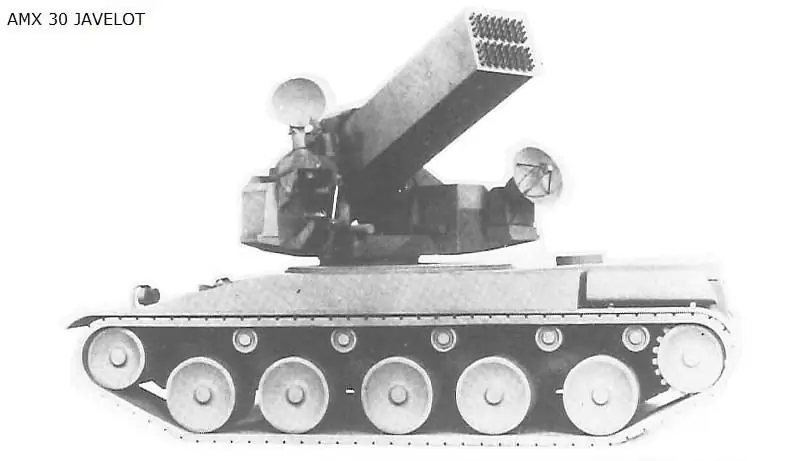
It was planned to compensate for the lack of controls on missiles with a perfect MSA, capable of calculating data for accurate shooting. Nevertheless, even in terms of the estimated probability of hitting a target with one salvo, Javelot was losing the air defense system of its time.
In this regard, the limited ammunition load of a combat vehicle could become a problem. SAM from the project could make no more than 12 volleys before reloading; the prototype had only 8 rounds of ammunition. In the course of the battle, a situation could arise in which one complex would be forced to spend all available missiles on only one or two targets.
Thus, the result of the Javelot project was an anti-aircraft complex with a characteristic appearance with minimal advantages and a number of significant disadvantages. This technique did not interest the French military, which led to the termination of the project. Naturally, the new development was not introduced to the international market.
During the AMX Javelot project, French engineers studied and worked out an interesting concept of an anti-aircraft missile system with unguided rockets. The finished project turned out to be interesting from a technical point of view, but unpromising. The customer studied the design capabilities of the new sample - and decided to abandon the entire direction. In the future, France developed only "traditional" air defense systems.






